Technologies
Dune: Spice Wars Early Access Preview — Beautiful but Complicated
This video game brings Arrakis to life in impressive detail, but controlling the planet will take all of your focus.
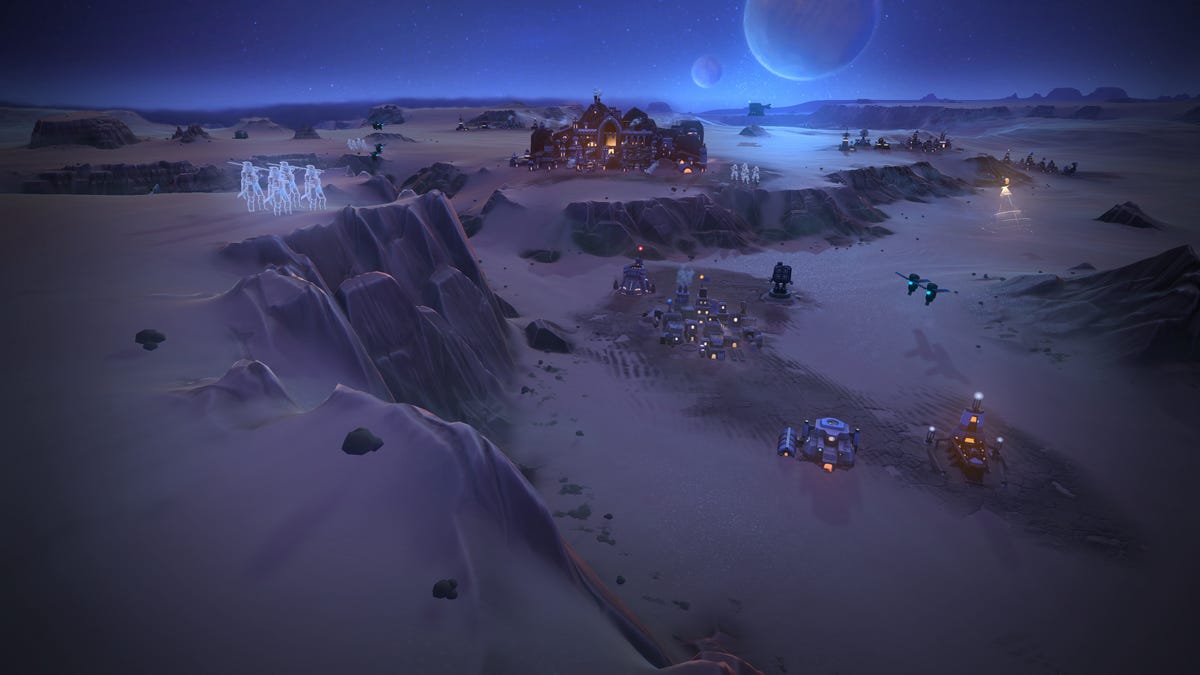
The timer on my phone pinged me as I crossed my fourth hour in Dune: Spice Wars, and I felt good about my progress. I commanded a massive Fremen army through Sietch Tabr, and my crew of Fedaykin had just reclaimed an area from the Harkonnen. I heard the familiar «for Liet!» as I sent another wave in to support this new outpost, successfully boxing in what was left of the Baron’s forces. What started as a battle of four armies was about to be reduced to two, and the final army hadn’t taken any new territories from me in over an hour. Victory felt close, which was why my heart sunk extra deep when the message that I’d just been defeated unexpectedly filled the screen. While I was busy waging war on the surface of Arrakis, the leader of The Smugglers had bought enough favor within the Landsraad to secure all the support needed to ensure the planet would be under their control for the foreseeable future.
If none of that made sense to you and your only exposure to Arrakis is what you saw in Denis Villeneuve’s 2021 Dune movie, Dune: Spice Wars may not be for you. Like the Dune universe itself, this strategy game is complex in ways I still don’t feel like I fully grasp, even a week after this game in the Early Access form being made publicly available on Tuesday, 26 April. But if you’re already a fan of the generations of stories told around planet Arrakis and have a lot of time to spend on a deep strategy game, you’re going to have a great time even if the computer delivers a sudden and crushing defeat.
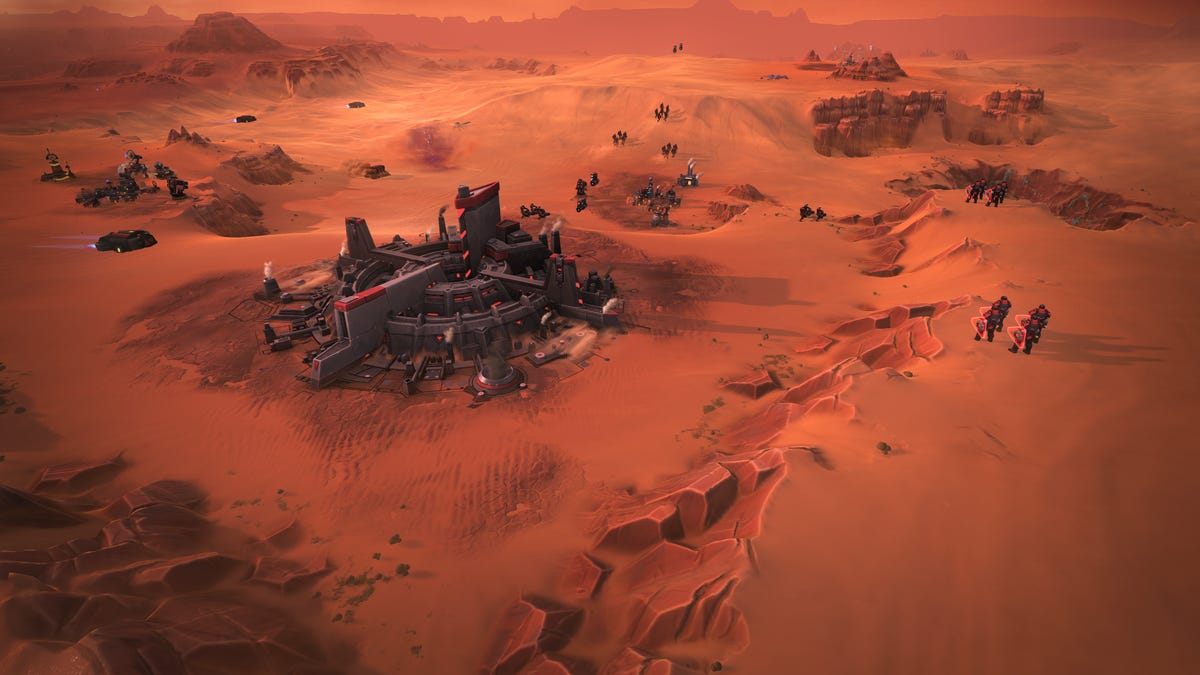
Dune: Spice Wars starts you off with a choice between four familiar armies: House Arrakis, House Harkonnen, The Fremen and The Smugglers. Each of these armies have essentially the same goal — to control Arrakis through any means possible. And in this real-time strategy game with 4X elements, meaning the goals are to expand, exploit, exterminate and explore, victory can come in one of three ways depending on how you play. You can take the classic strategy route and crush your enemies through sheer overwhelming violence, you can control all of the governing positions of Arrakis and rule as a duly elected leader or you can seek a victory through hegemony and buy control of Arrakis through influence gained throughout a campaign. Neither path is necessarily easier than the other, but your play preference will influence which outcome is the most readily available.
Each army has obvious strengths and weaknesses for each of these victory conditions. The beloved House Atreides makes a victory through governance easier, while Harkonnen could more easily win through hegemony if you took that path. The Smugglers are natural spies and influencers, great at building trust through trade, while Fremen of Sietch Tabr have the unique ability to gain desert power through partnership with other Sietches as you come across them. Each army is more than capable of victory through domination, but that only works in your favor if the other armies aren’t hiding in a corner of the map trying to win through other means.
No matter which army you choose or how you decide to play, once the fight for Arrakis begins you have so much to do. There are constant distractions from the task at hand, from Landsraad council votes to internal rebellions stoked by enemy armies to constant random sandworm attacks. Ignoring any of these things has dangerous consequences: Your enemies might gang up on you and encourage the Landsraad to double your cost to train soldiers or a village may suddenly turn on you and the militia garrisoned there may choose to burn it all down, forcing you to start over again. This is a separate process from maintaining your own intelligence and counterintelligence missions and making sure you have enough resources to keep expanding your empire. Oh, and the longer the game goes on, the more spice needs to be paid to CHOAM or you’ll get new taxes on other resources. It’s a lot, and can become overwhelming late in the game.
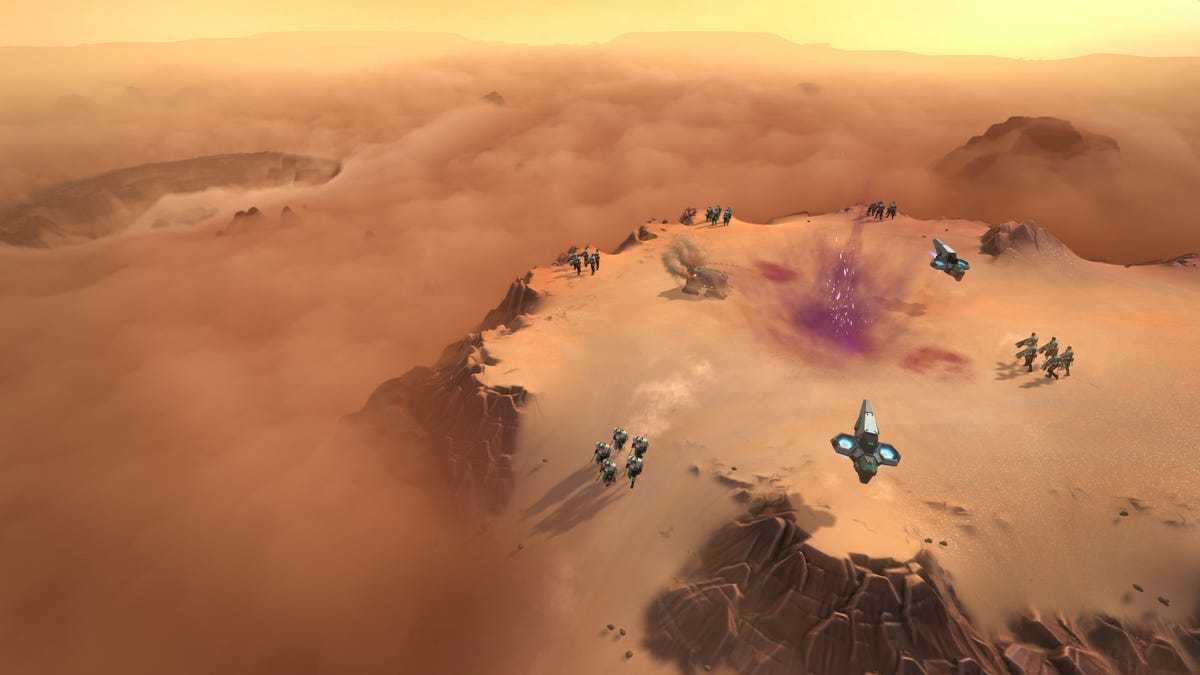
This might not be such a challenge to manage if the folks at Shiro Games had seen fit to give this game a proper tutorial. Instead, at the start of your first play-through there’s a set of text and image slides you can click through to explain how it all works. But there are so many different systems and menus that a more interactive and playable tutorial would help you along. More than this, the first couple of minutes in this game are crucial. While you’re reading a tutorial, the other three armies are securing their second spice field. The game deserves a better introduction, and I hope it gets added before this title leaves early access on Steam.
To the credit of the folks at Shiro Games, this game is easily the most faithful to the Dune universe that I’ve played. While the Atreides and Harkonnen need to rely on spice harvesters which need to be rescued at wormsign or conflict from another army, Fremen spice gatherers have no such difficulties. There are some troop types that rely on projectile weaponry, but it’s not the dominant form of combat. There are clear places the sandworms can’t travel, the movement and combat types for each army are varied in ways that make sense and the larger map feels consistent with Arrakis in the books. It’s not perfect — at one point I was playing as the Fremen and spotted a roaming group of soldiers the game had simply labeled «Locals,» which doesn’t make any sense at all — but this is loads better than what Dune fans have had in the past. I also lost a Fedaykin squad to a sandworm attack, which is technically possible in the context of the world but feels extremely unlikely given who the Fedaykin warriors are.
Dune: Spice Wars is fun even when I’m losing, but I’m also very much the target audience here. I’ve been reading these books for going on 25 years, and many of my teenage evenings and weekends were spent playing Dune II, Dune 2000 and Emperor: Battle for Dune. I get a genuine kick out of being able to zoom in and see an Ornithopter scanning a new area, or watching a Harkonnen hit squad fire up their half-shields before rushing into battle. But if I’m being totally honest, I don’t have time to dedicate 5 hours to a game on a regular basis, so I’d love to be able to jump into a quick skirmish where the only victory condition was domination. This game is great if you’re a huge Dune fan who also loves 4X strategy games and has a lot of time on your hands, but that venn diagram doesn’t have a ton of overlap. I hope Shiro Games uses the time in Early Access to at least address the learning curve so it won’t push away what audience it has.
Technologies
Today’s NYT Strands Hints, Answers and Help for Nov. 28 #635
Here are hints and answers for the NYT Strands puzzle for Nov. 28, No. 635.
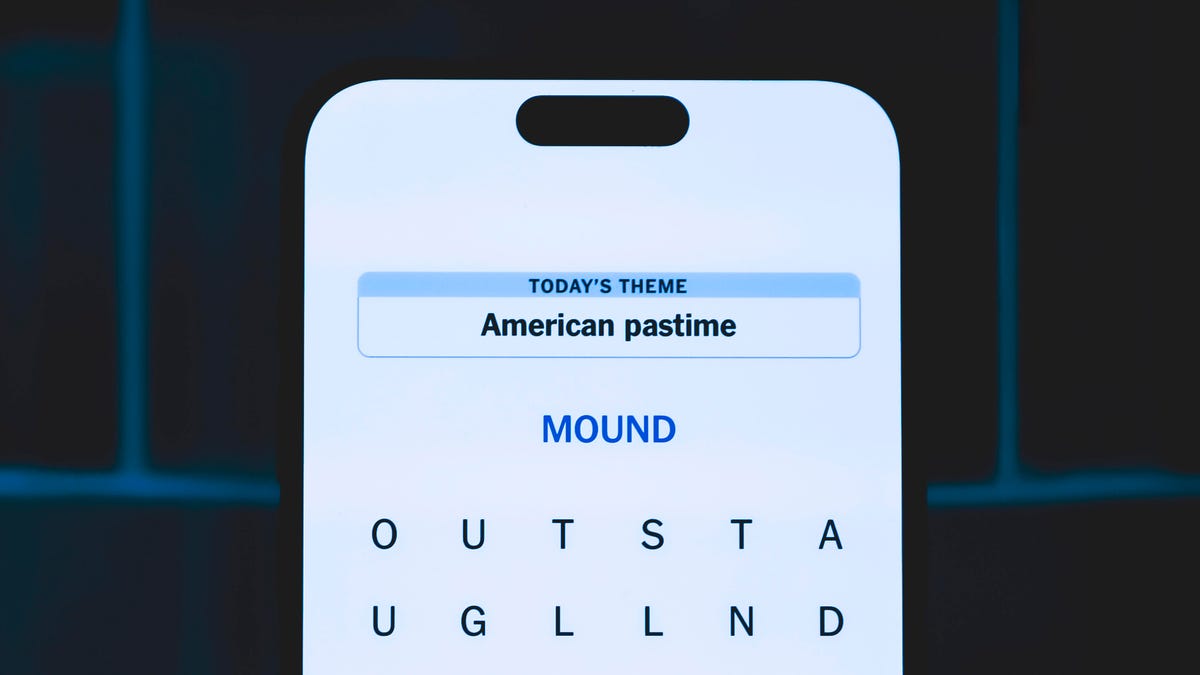
Looking for the most recent Strands answer? Click here for our daily Strands hints, as well as our daily answers and hints for The New York Times Mini Crossword, Wordle, Connections and Connections: Sports Edition puzzles.
Today’s NYT Strands puzzle is pretty tricky. If you’re not familiar with certain superstitious beliefs, you might not find all the answers. And some of the answers are difficult to unscramble, so if you need hints and answers, read on.
I go into depth about the rules for Strands in this story.
If you’re looking for today’s Wordle, Connections and Mini Crossword answers, you can visit CNET’s NYT puzzle hints page.
Read more: NYT Connections Turns 1: These Are the 5 Toughest Puzzles So Far
Hint for today’s Strands puzzle
Today’s Strands theme is: If all else fails…
If that doesn’t help you, here’s a clue: Don’t tell, it won’t come true.
Clue words to unlock in-game hints
Your goal is to find hidden words that fit the puzzle’s theme. If you’re stuck, find any words you can. Every time you find three words of four letters or more, Strands will reveal one of the theme words. These are the words I used to get those hints but any words of four or more letters that you find will work:
- GLUB, RATS, TARN, DALE, FONT, FOUNT, LASH
Answers for today’s Strands puzzle
These are the answers that tie into the theme. The goal of the puzzle is to find them all, including the spangram, a theme word that reaches from one side of the puzzle to the other. When you have all of them (I originally thought there were always eight but learned that the number can vary), every letter on the board will be used. Here are the nonspangram answers:
- DANDELION, STAR, COIN, FOUNTAIN, LADYBUG, EYELASH
Today’s Strands spangram
Today’s Strands spangram is MAKEAWISH. To find it, start with the M that’s three letters down on the far right, and wind backwards.
Technologies
Today’s NYT Connections Hints, Answers and Help for Nov. 28, #901
Here are some hints and the answers for the NYT Connections puzzle for Nov. 28, #901.
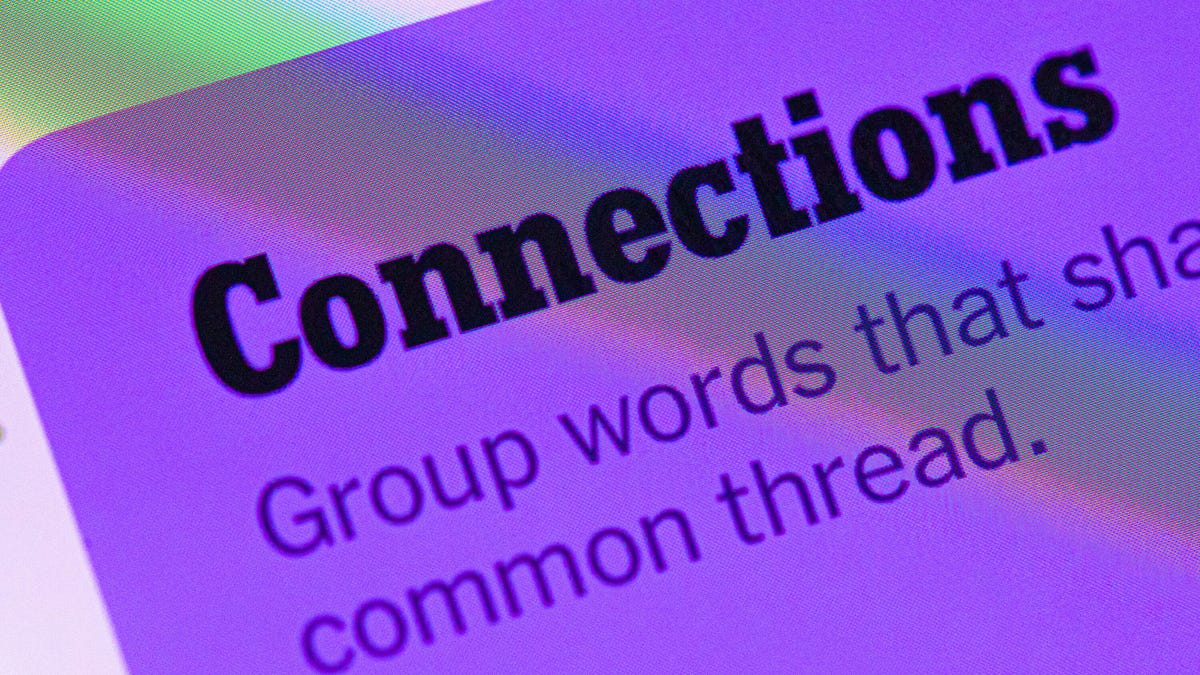
Looking for the most recent Connections answers? Click here for today’s Connections hints, as well as our daily answers and hints for The New York Times Mini Crossword, Wordle, Connections: Sports Edition and Strands puzzles.
Today’s NYT Connections puzzle is kind of tough. If you need help sorting the answers into groups, you’re in the right place. Read on for clues and today’s Connections answers.
The Times now has a Connections Bot, like the one for Wordle. Go there after you play to receive a numeric score and to have the program analyze your answers. Players who are registered with the Times Games section can now nerd out by following their progress, including the number of puzzles completed, win rate, number of times they nabbed a perfect score and their win streak.
Read more: Hints, Tips and Strategies to Help You Win at NYT Connections Every Time
Hints for today’s Connections groups
Here are four hints for the groupings in today’s Connections puzzle, ranked from the easiest yellow group to the tough (and sometimes bizarre) purple group.
Yellow group hint: Appropriate.
Green group hint: I win!
Blue group hint: Musical instrument.
Purple group hint: Time to talk.
Answers for today’s Connections groups
Yellow group: Fitting.
Green group: Achieve victory over.
Blue group: Parts of an electric guitar.
Purple group: Phonetic elements of speech.
Read more: Wordle Cheat Sheet: Here Are the Most Popular Letters Used in English Words
What are today’s Connections answers?
The yellow words in today’s Connections
The theme is fitting. The four answers are fair, just, proper and right.
The green words in today’s Connections
The theme is achieve victory over. The four answers are beat, best, take and worst.
The blue words in today’s Connections
The theme is parts of an electric guitar. The four answers are fret, peg, pickup and string.
The purple words in today’s Connections
The theme is phonetic elements of speech. The four answers are intonation, loudness, rhythm and stress.
Technologies
Anker’s New MagSafe Car Mount Keeps Your Phone Cool While Charging, and It’s 30% Off for Black Friday
Get wired-like charging speeds and MagSafe compatibility with Anker’s wireless car charging bundle for $62.99.
Black Friday is the best time of the year to upgrade the little essentials that make your everyday tech life more pleasant. I’ve found the perfect deal to amp up the phone charging setup in your car. This Anker MagSafe wireless car charging bundle is 30% off for the holidays, and it gives your iPhone a fast and steady way to power up while you navigate. It delivers up to 25-watt wireless charging speeds and with onboard active cooling, your phone stays comfortable to the touch.
Get it now for $62.99 verses the list price of $89.99.
What sets this charger apart is that its performance and cooling tech is built into a surprisingly compact package. The stand uses an ultra-strong Qi2 magnetic lock to keep your phone secure through bumps and turns. You can even tilt the mount and switch between portrait and landscape modes for navigation without blocking the view. The bundle has everything you need to get started including a 60-watt dual-USB-C charger, an adequately long USB-C cable, and cable organizers for a clean setup. Anker also includes a two-year warranty for peace of mind.
If you are getting your car prepped up for driving to a holiday vacation or just need a faster charging mount for your daily commute, this deal makes a lot of sense. CNET’s experts are also tracking more Black Friday and Cyber Monday picks across Apple products, headphones, and more, so you can score more savings before the sales season wraps up.
MOBILE DEALS OF THE WEEK
-
$749 (save $250)
-
$475 (save $175)
-
$499 (save $300)
-
$900 (save $400)
Why this deal matters
A high quality charger is a great addition to any car to speedily top up your phone on the go. You will especially want to look out for options from a top-tier brand like Anker for its fast charging speeds and reliability. This Black Friday deal is an excellent opportunity to save big on a staple car accessory. With holiday shopping heating up and tech accessories being one of the most popular categories, we expect the deal to sell out quick. So don’t wait too long before jumping on it.
Don’t miss any of our unbiased tech content and lab-based reviews. Add CNET as a preferred Google source.
Join Our Daily Deals Text Group!
Get hand-picked deals from CNET shopping experts straight to your phone.
By signing up, you confirm you are 16+ and agree to receive recurring marketing messages at the phone number provided. Consent is not a condition of purchase. Reply STOP to unsubscribe. Msg & data rates may apply. View our Privacy Policy and Terms of Use.
-

 Technologies3 года ago
Technologies3 года agoTech Companies Need to Be Held Accountable for Security, Experts Say
-

 Technologies3 года ago
Technologies3 года agoBest Handheld Game Console in 2023
-

 Technologies3 года ago
Technologies3 года agoTighten Up Your VR Game With the Best Head Straps for Quest 2
-

 Technologies4 года ago
Technologies4 года agoBlack Friday 2021: The best deals on TVs, headphones, kitchenware, and more
-

 Technologies4 года ago
Technologies4 года agoVerum, Wickr and Threema: next generation secured messengers
-

 Technologies4 года ago
Technologies4 года agoGoogle to require vaccinations as Silicon Valley rethinks return-to-office policies
-

 Technologies4 года ago
Technologies4 года agoOlivia Harlan Dekker for Verum Messenger
-

 Technologies4 года ago
Technologies4 года agoiPhone 13 event: How to watch Apple’s big announcement tomorrow
